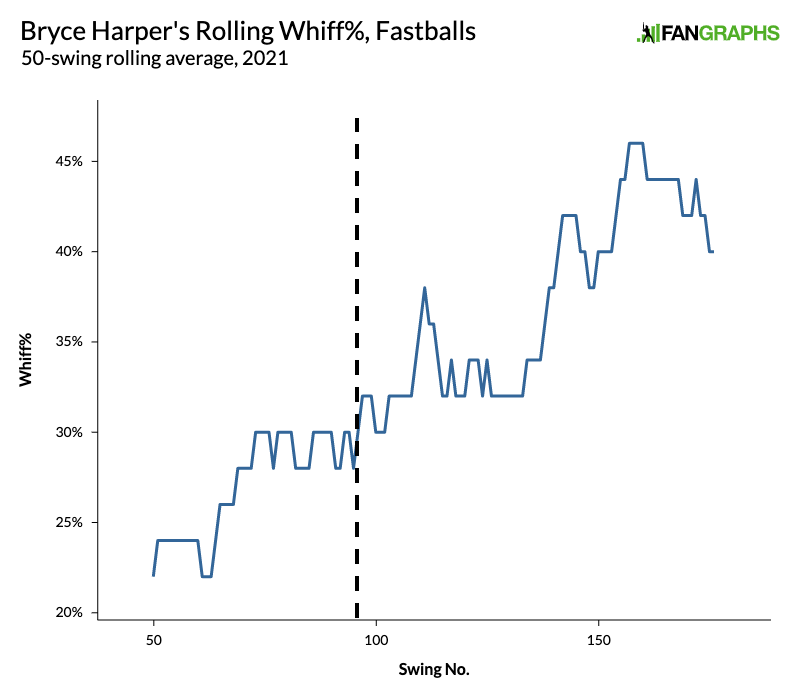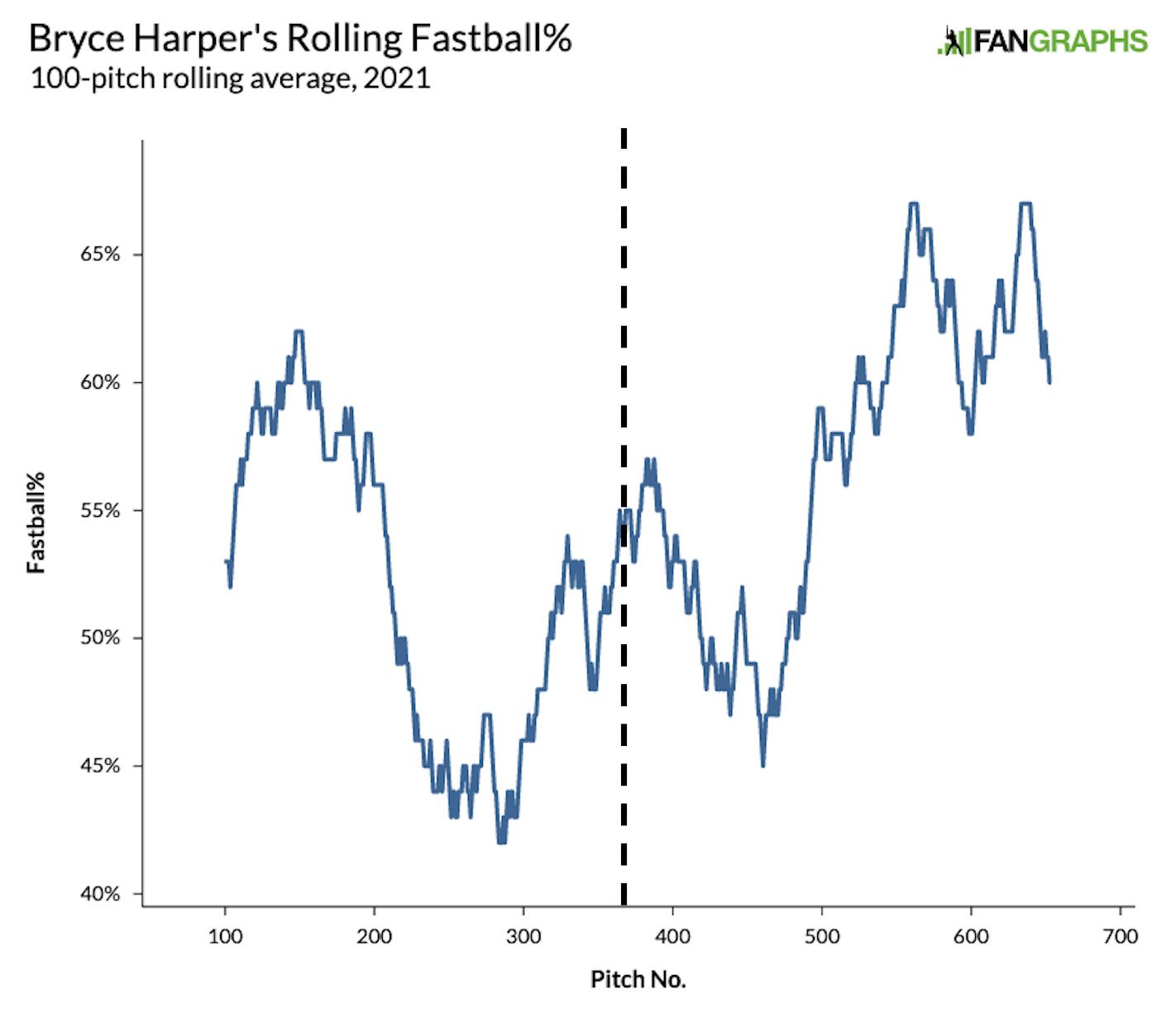Bryce Harper Was Clearly Playing Hurt
On Tuesday, the Phillies placed Bryce Harper on the 10-day injured list with a bruised left wrist after insisting for days that their star rightfielder was healthy. Last Sunday, when asked if Harper was out of the lineup due to any medical issues, manager Joe Girardi flatly told reporters, including Matt Gelb of The Athletic, “No. [It’s] just a day off. Just a day off.” When Harper missed a second consecutive game, Girardi again denied that anything was wrong, saying, “I went to bed last night, woke up this morning and said, ‘You know what? I’m going to give him another day.’ And that’s the reason.”
But once Harper was officially on the IL, Girardi finally admitted that he had been dishonest with the media, citing that he’d face a competitive disadvantage if he noted publicly that Harper’s wrist was causing him discomfort. “There is a distinct advantage to the other manager if I tell you a guy’s wrist is hurt,” he said. “And the idea here is to win games…. I understand you want to know. But there are distinct advantages that I can give another club if they know everything that’s going on over here. So I’m sorry that I had to do that. But we’re trying to win games, and he’s just not ready to go. I thought he’d be ready on Monday or Tuesday. He’s not.”
We know exactly when Harper was injured. It goes back to this ugly hit-by-pitch from Génesis Cabrera on April 28:
Even though that pitch looked to have hit him in the face, Harper’s wrist was actually causing him more discomfort, according to Phillies bench coach Rob Thompson. The data bears that out. Take a look at Harper’s 30-batted ball rolling average exit velocity. His 60th batted ball was his first post-April 28, and the trend is pretty much exactly what you’d expect for a player dealing with a wrist injury:

As Gelb mentions in his piece, Harper’s swing-and-miss rate spiked in May. His 37% whiff rate on pitches inside the strike zone during that month was the worst of his career, and a closer look at the data suggests that he was unable to catch up to any fastballs post-HBP:

Harper was whiffing at 24.2% of fastballs prior to the HBP, a rate that was a touch worse than his career-average into this season (21.1%), but one that still represented a small year-over-year (25.1% rate in 2020) improvement. Since April 28, though, Harper has come up empty on nearly 41% of fastballs on 81 total swings. This is the highest whiff rate Harper has ever had on fastballs in any 81-fastball swing sample:

Harper has had some bad stretches before, but again, it seems unlikely that he’d post the first 40-plus whiff rate on fastballs of his career by chance, especially when we (finally) have it on the record that he’s been trying to play through a wrist injury sustained on a HBP.
As you’d expect, with Harper’s average exit velocity on batted balls going down and his whiff rate — particularly on fastballs — going up, it’s not surprising that his season stats have suffered greatly. Here are his numbers divided into two self-explanatory groups: games through April 28 and games after April 28.
| Date | PA | AVG | OBP | SLG | wOBA | wRC+ | EV | xwOBA |
|---|---|---|---|---|---|---|---|---|
| 4/1-4/28 | 96 | .321 | .448 | .615 | .448 | 185 | 93.5 | .522 |
| 4/29-5/22 | 66 | .211 | .318 | .316 | .284 | 78 | 87.4 | .283 |
The 78 wRC+ post-HBP is not the lowest 15-game stretch Harper has put up since the beginning of 2020, but you’d have to go all the way back to 2018 to find one where he’s struck out as often. The numbers would’ve been even worse if Harper were facing poor batted ball luck; his .367 BABIP is the only thing that kept him afloat.
In that time, Harper’s numbers have dipped. On the season, he’s hitting .274/.395/.489 — a good line in a vacuum, albeit with less-than-expected power numbers. But considering how hot he was to start the year, it’s a little depressing to see such a huge drop-off in just about everything. As for the power specifically, just as we saw with his average exit velocity, his ISO took a huge hit following the HBP: .294 before the injury, .105 since.
More generally, Harper also has somewhat of a reputation of being a hot starter before cooling off. There is some truth to that: His career 168 wRC+ in March/April is his best in any calendar month. But the May production has never been as bad as it was this season, again suggesting that this is beyond the scope of the traditional ebb and flow of Harper’s performance:
| Season | April | May | Difference |
|---|---|---|---|
| 2013 | 216 | 90 | 126 |
| 2014 | 115 | Injured | N/A |
| 2015 | 161 | 262 | -101 |
| 2016 | 177 | 104 | 73 |
| 2017 | 220 | 116 | 104 |
| 2018 | 153 | 121 | 32 |
| 2019 | 124 | 107 | 17 |
| 2021 | 185 | 78 | 107 |
So even though this data gives credence to the idea that Harper is a fast starter, no May was as bad as this one. That includes other seasons when he dealt with injuries, such as 2013, when he hurt his knee on May 13 running into the outfield wall at Dodger Stadium. That year, though, he still posted a 90 wRC+ in May, which included 38 trips to the plate after the collision. Minimum 50 plate appearances, Harper’s May 2021 was the fourth-worst month of his career by wRC+ and the worst month of his career by strikeout rate.
Ultimately, it looks a little foolish in retrospect for Girardi to claim that everything was fine and that Harper wasn’t trying to play through something. But the decision to put him on the IL isn’t solely his own, and I can understand why Girardi would want to mince words about a wrist injury given that Harper was still on the active roster. With that said, a quick look at the data pretty clearly showed that something wasn’t right, and pitchers figured it out. Just look at Harper’s fastball rate:

There was an adjustment period, but I think that chart does provide at least some evidence that Harper’s inability to hit the fastball was figured out, and that Girardi saying he didn’t want face a competitive disadvantage was somewhat of a moot point. Pitchers knew what was going on, and they made Harper struggle through May as a result. Perhaps the real competitive disadvantage was waiting to put him on the IL until now.
Devan Fink is a Contributor at FanGraphs. You can follow him on Twitter @DevanFink.

Great article. I guess the bigger question is how this will affect Harper going forward.
Nomaaahhh, anyone?